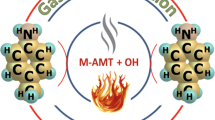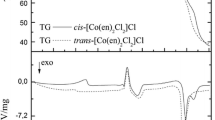Abstract
Carbon-13 fractionation observed in the course of carbon monoxide formation in the reaction of phenylacetylene with the large excess of liquid formic acid in the temperature interval 20–100°C has been investigated and compared with the13C fractionation in the dehydration of pure liquid formic acid. The anomalous temperature dependence of the13C fractionation has been interpreted as caused by the change of the kinetics and of the mechanism of CO formation from the one involving13C−H bond rupture rate determining step (operating in the presence of phenylacetylene) to the mechanism according to which HCOOH decarbonylates in liquid state. No large increase of the13C fractionation with rising of the reaction temperature from 70 to 134°C has been found in the case of decarbonylation of F.A. in the presence of large excess of phenylacetylene. The13C KIE was of 1.020 in the temperature interval 90–133.7°C in this case.
Similar content being viewed by others
References
N. MENASHE, D. RESHEF, Y. SHVO, J. Org. Chem., 56 (1991) 2912.
N. MENASHE, Y. SHVO, J. Org. Chem., 58 (1993) 7434.
J. MARCH, Advanced Organic Chemistry, John Wiley, New York, 1985, p. 683.
M. ROTEM, I. GOLDBERG, U. SHMUELI, Y. SHVO, J. Organomet. Chem., 314 (1986) 185.
M. ROTEM, Y. SHVO, J. Organomet. Chem., 448 (1993) 189.
J. P. MONTHEARD, M. CAMPS, A. BENZAID, Synthetic Commun., 13 (1983) 663.
M. ZIELIŃSKI, A. ZIELIŃSKA, J. Radioanal. Nucl. Chem., 198 (1995) 3.
M. ZIELIŃSKI, A. ZIELIŃSKA, H. PAPIERNIK-ZIELINSKA, Isotopes Environ. Health Stud., 32 (1996) 1.
M. ZIELIŃSKI, A. ZIELIŃSKA, H. PIERNIK-ZIELINSKA, J. Radioanal. Nucl. Chem., 183 (1994) 301.
P. E. YANKWICH, R. H. HASCHEMEYER, J. Phys. Chem., 67 (1963) 694.
M. ZIELIŃSKI, Nucl. Appl., 2 (1966) 51.
M. ZIELIŃSKI, M. KAŃSKA, in: The Chemistry of Sulphenic Acids and their Derivatives, S. PATAI (Ed.), John Wiley, Chichester, 1990, Chapter 14, p. 641.
H. N. BARHAM, L. W. CLARK, J. Am. Chem. Soc., 73 (1951) 4638.
R. C. MILLIKAN, K. S. PITZER, J. Am. Chem. Soc., 80 (1958) 3515.
Y. T. CHANG, Y. YAMAGUCHI, W. H. MILLER, H. F. SCHAEFER, J. Am. Chem. Soc., 109 (1987) 7245.
J. E. BERTIE, K. H. MICHAELIAN, J. Chem. Phys., 76 (1982) 886.
J. D. GODDARD, Y. YAMAGUCHI, H. F. SCHAEFER, J. Chem. Phys., 96 (1992) 1158.
J. S. FRANCISCO, J. Chem. Phys., 96 (1992) 1167.
K. H. LIESER, Einführung in die Kernchemie, Verlag Chemie GmbH, Weinheim, 1968, p. 122.
G. A. ROPP, J. Am. Chem. Soc., 82 (1960) 842.
Author information
Authors and Affiliations
Rights and permissions
About this article
Cite this article
Zieliński, M., Papiernik-Zielińska, H., Zielińska, A. et al. Carbon isotope effect studies in the mechanism of reactions of alkynes with formic acid. Journal of Radioanalytical and Nuclear Chemistry Articles 210, 15–25 (1996). https://doi.org/10.1007/BF02055402
Received:
Issue Date:
DOI: https://doi.org/10.1007/BF02055402




